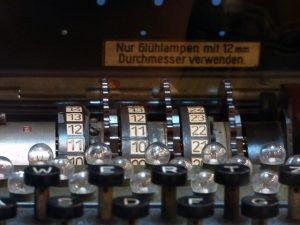Cryptograms are Good Fun to Decipher

Enigma cryptogram machine from WWII
But spies need to be able to send messages that the recipient can understand without having to spend hours deciphering and possibly getting wrong. Spies use ciphers and codes as a means of securing their communications and protecting sensitive information from unauthorized access. The primary goal is to ensure that messages remain confidential and cannot be easily intercepted or understood by anyone other than the intended recipient. You may wish to try creating and deciphering coded messages with your friends.
Spies Use Ciphers For
Confidentiality
Ciphers help maintain the confidentiality of information. By encrypting messages, spies can prevent adversaries or unauthorized individuals from understanding the content of their communications.
Security
Spies often operate in environments where information security is critical. The use of ciphers adds an additional layer of security to their communications, making it more challenging for adversaries to gain access to sensitive data.
Covert Communication
In espionage, it’s crucial to maintain covert communication to avoid detection by the enemy. Ciphers allow spies to convey messages without revealing the true meaning to unintended recipients.
Authentication
Some cryptographic techniques can also be used for authentication. By including specific cryptographic elements in a message, spies can verify the authenticity of the sender and ensure that the message has not been tampered with during transmission.
Integrity
Ciphers help maintain the integrity of messages by protecting them from unauthorized alterations. If a message is intercepted, the use of ciphers makes it difficult for adversaries to modify the content without detection.
Deniability
Using ciphers allows spies to deny or downplay the significance of intercepted messages. Even if a message is intercepted, the encrypted content may be challenging to decipher without the proper key, providing a level of deniability for the sender.
Tradition and Training
The use of ciphers is deeply ingrained in the tradition of espionage. Spies often receive training in cryptography and encryption techniques to ensure the secure exchange of information.
Adaptation to Technology
As technology advances, spies must adapt to new methods of communication and potential threats. The use of sophisticated ciphers helps them stay ahead of technological advancements and maintain secure communication channels.
So, spies use ciphers as a fundamental tool for maintaining the confidentiality, security, and integrity of their communications, allowing them to operate effectively in covert and sensitive environments.
Cipher Key
When sending a ciphered message, the sender and the recipient both need to know how to create and decipher the code. This needs some kind of key. Establishing a secure method to communicate the cipher key is a critical aspect of encrypted communication. Spies use various techniques to securely share cipher keys with the intended recipients. Here are some common methods:
Pre-arranged Codes
Spies often use pre-arranged codes or phrases that signal the use of a specific cipher or key. These codes are known only to the parties involved and are typically designed to appear innocuous or irrelevant to outsiders.
Dead Drops
A dead drop involves leaving physical or digital information in a predetermined, hidden location. The recipient is informed of the location and retrieves the information at a later time. This method is less direct but adds an extra layer of security.
Steganography
Steganography is the practice of concealing information within other seemingly innocuous data. Spies may embed cipher keys within images, text, or other files, and the recipient knows how to extract the hidden information.
One-Time Pads
One-time pads are a form of encryption where a unique key is used only once. The sender and recipient must possess identical pads, which are securely distributed in advance. One-time pads are extremely secure but require careful management to prevent reuse.
Personal Meetings
Face-to-face meetings between spies and their contacts provide an opportunity to exchange cipher keys directly. This method ensures that the key is shared securely, assuming the meeting is conducted in a secure environment.
Secure Communication Channels
Spies may use secure communication channels, such as encrypted messaging apps, to share cipher keys. These channels employ strong encryption to protect the confidentiality of the information being exchanged.
Invisible Ink
Traditional methods, such as invisible ink, may be used to hide cipher keys on physical documents. The recipient knows how to reveal the hidden information using the appropriate method. One well known one is to use lemon juice to write the message. Once the paper is dry, nothing can be seen but when the paper is heated, the writing shows up as brown ink.
Morse Code or Signaling
In situations where direct communication is challenging, spies might use Morse code or other signaling methods to convey the cipher key. This could involve coded messages using light signals, sound signals, or other forms of non-verbal communication.
It’s important to note that the choice of method depends on the specific circumstances, level of security required, and the resources available to the spies. The key is to establish a secure and reliable means of communication to ensure that cipher keys are exchanged without falling into the wrong hands.